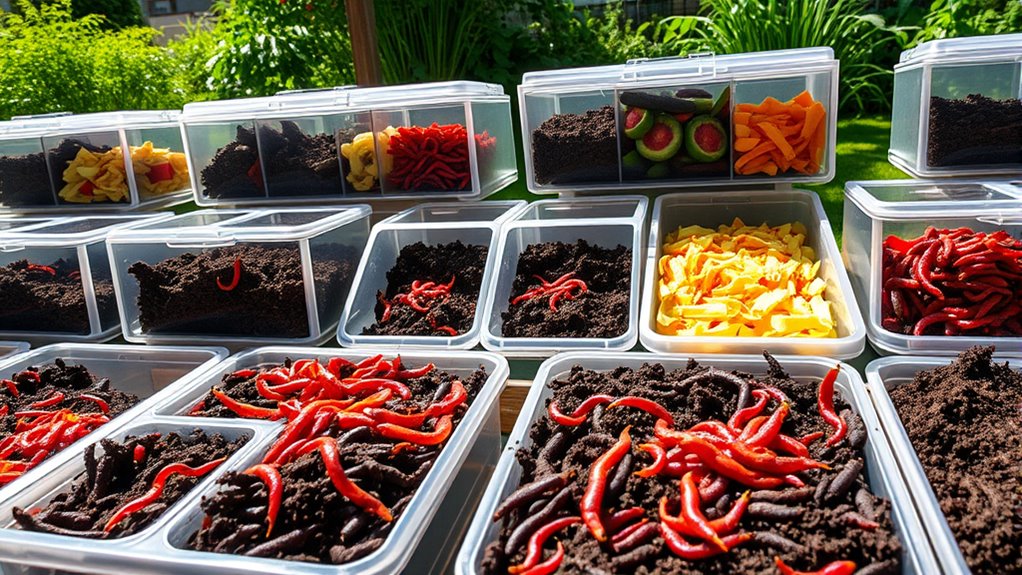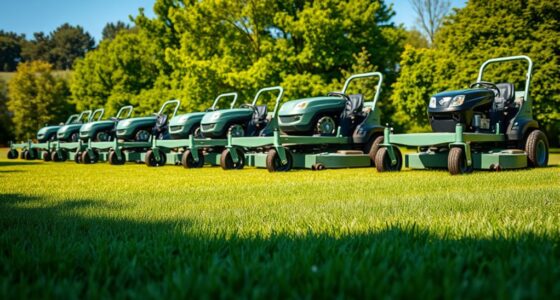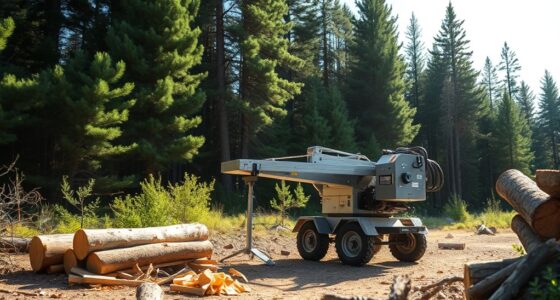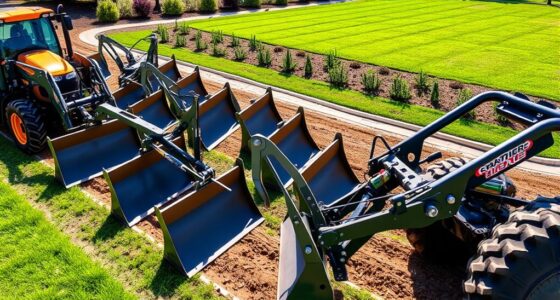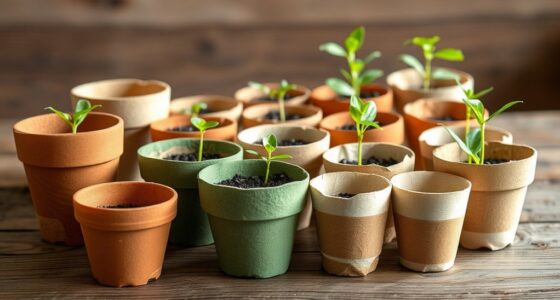If you’re looking to turn kitchen waste into rich soil, I recommend exploring some of the best worm composting bins like the Vermihut Plus, Vevor’s 50L composter, Worm Factory 360, and underground worm farms. These options are designed for easy use, durability, good airflow, and odor control. Whether you want indoor, outdoor, or in-ground systems, there’s a model suited for your space. Keep going, and you’ll find all the details to choose the perfect setup.
Key Takeaways
- Look for durable, weather-resistant materials like BPA-free HDPE or polypropylene for outdoor use.
- Choose systems with multi-tray designs and good ventilation for efficient composting and easy harvesting.
- Consider capacity options from small countertop bins to large capacity units for household waste.
- Prioritize features like odor control, liquid collection, and easy assembly for hassle-free maintenance.
- Opt for models with positive reviews that balance affordability, durability, and effective composting performance.
The Original Vermihut Plus 5 Worm Composter
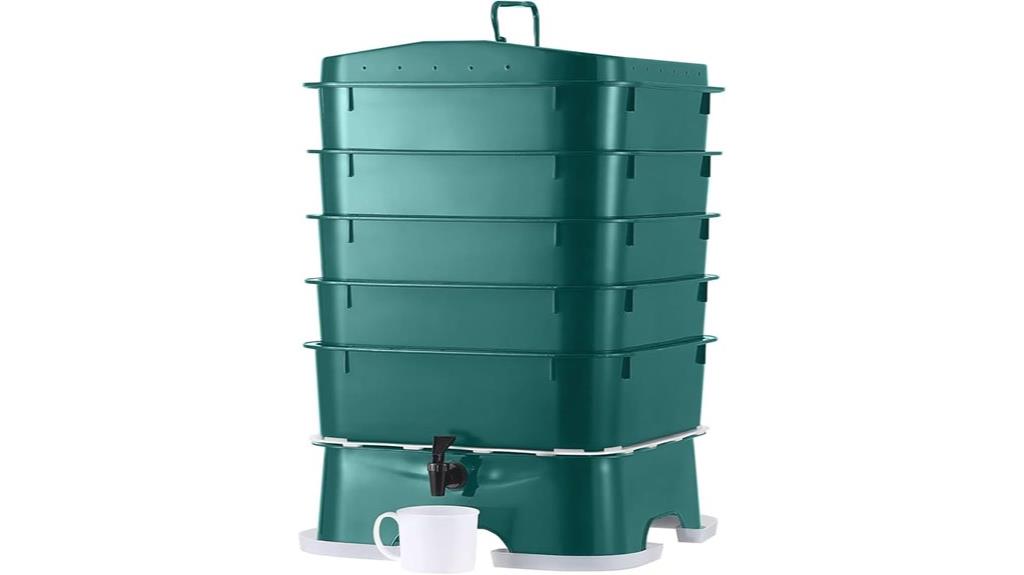
If you’re looking for a durable, scalable worm compost bin that’s perfect for both beginners and experienced composters, the Original Vermihut Plus 5 Worm Composter stands out. Its sleek dark green design suits indoor and outdoor use, and the five-tray system makes it easy to customize your composting setup. The upgraded airflow via the M-board keeps worms healthy and composting efficient, while the odor-vented lid with coconut fiber helps control smells and moisture. Plus, the single-piece base and liquid tray simplify assembly. With included tools and free expert support, this bin offers everything you need for successful vermicomposting.
Best For: beginners and experienced composters seeking a durable, scalable, and efficient worm composting solution suitable for both indoor and outdoor use.
Pros:
- Innovative airflow system with M-board enhances composting efficiency and worm health
- Odor-vented lid with coconut fiber helps control smells and moisture effectively
- Single-piece base and liquid tray simplify assembly and maintenance
Cons:
- May be more expensive than basic compost bins for entry-level users
- Requires space for multiple trays if scaling up the composting capacity
- Some users might need time to get accustomed to managing the additional accessories included
Vevor 5-Tray Composter, 50L Worm Compost Bin
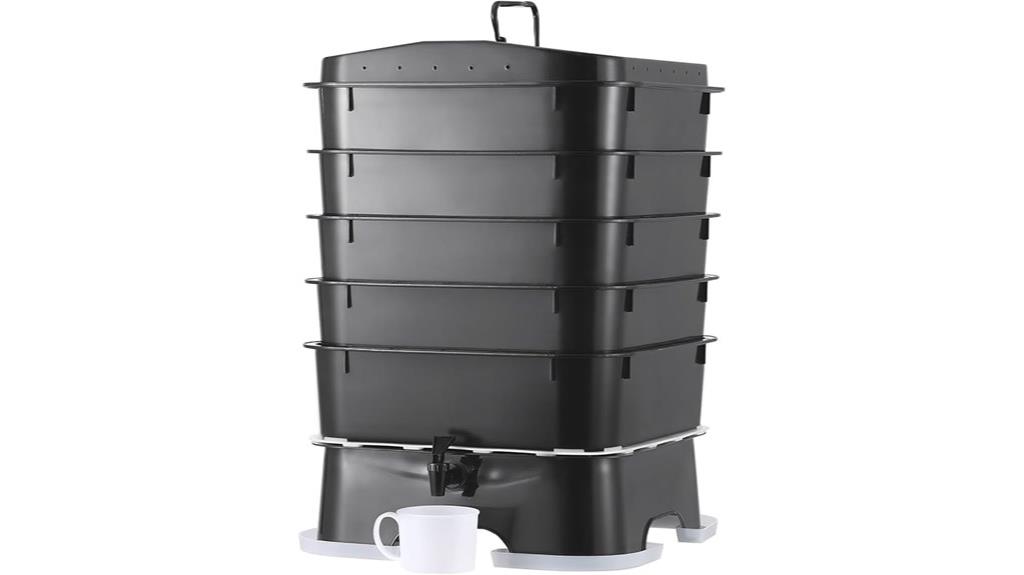
The Vevor 5-Tray Composter, with its 50-liter capacity and sturdy BPA-free HDPE construction, is an excellent choice for those seeking an efficient, space-saving worm composting system. Its compact size (15.75×15.75×16.14 inches) fits well in small indoor or outdoor spaces and can expand to over two feet high when fully loaded. Designed with five trays, a collection base, and a tap for liquid fertilizer, it processes kitchen scraps quickly—producing nutrient-rich compost in just 4-5 weeks. Built-in ventilation, coconut pads, and UV-resistant materials help control odors and prevent overheating, making it a reliable, eco-friendly solution for waste reduction and soil enrichment.
Best For: individuals seeking an efficient, space-saving indoor or outdoor worm composting system that produces nutrient-rich compost quickly.
Pros:
- Compact and expandable design fits small spaces and grows with your composting needs
- Durable, UV-resistant BPA-free HDPE construction ensures longevity and safety
- Fast processing time of 4-5 weeks for nutrient-rich compost production
Cons:
- Occasional setup confusion may require supplementary instructions or videos
- Worm escape issues can occur if trays are misaligned or environmental conditions are poor
- Maintaining optimal moisture and temperature conditions is essential to prevent odors and worm loss
Blütezeit 5-Tray Worm Compost Bin
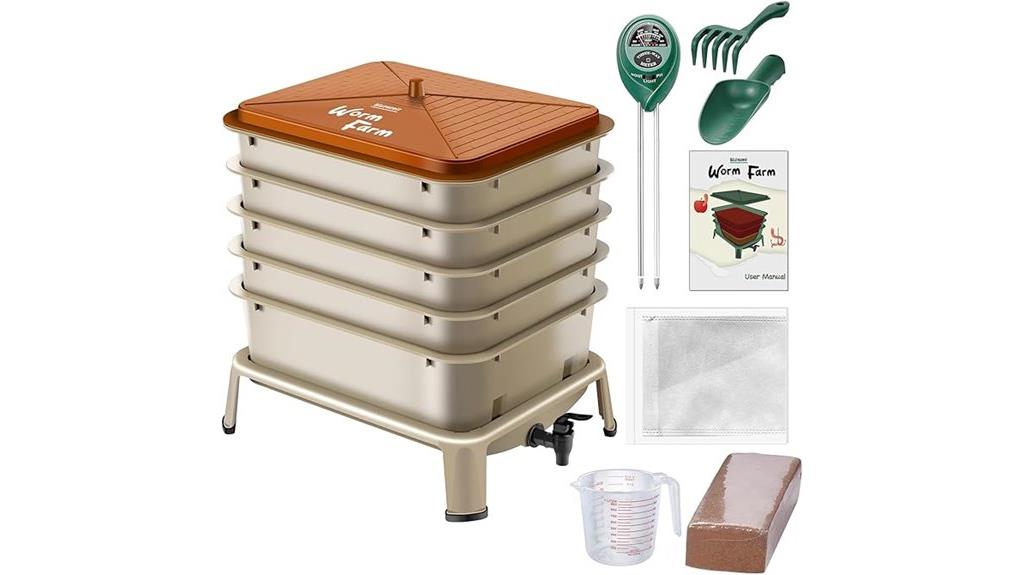
Designed for both beginners and seasoned composters, the Blütezeit 5-Tray Worm Compost Bin stands out with its multi-layer stacking system that enhances airflow and speeds up decomposition. Made from durable polypropylene, it’s compact yet spacious, holding about 13 gallons of organic waste. The stacking trays promote worm migration and allow easy expansion as your worm population grows. Ventilation holes in each tray keep the environment moist and odor-free, while the included spigot makes harvesting worm tea simple. Its thoughtful design suits indoor and outdoor use, making composting accessible, efficient, and clean for any space.
Best For: beginner and experienced composters seeking an efficient, odor-free, and space-saving worm composting solution for indoor or outdoor use.
Pros:
- Easy to set up and maintain, ideal for beginners
- Durable polypropylene construction with multi-tray design enhances airflow and decomposition speed
- Includes accessories like a spigot for easy worm tea harvesting and a moisture/pH meter for optimal environment control
Cons:
- Limited capacity of approximately 13 gallons may require frequent harvesting for large waste volumes
- Requires regular monitoring to prevent worm escape and maintain proper conditions
- The multi-tray system may be more complex for users unfamiliar with vermicomposting setup
FCMP Outdoor Living Composter (HF-LC4000v2-GRY)
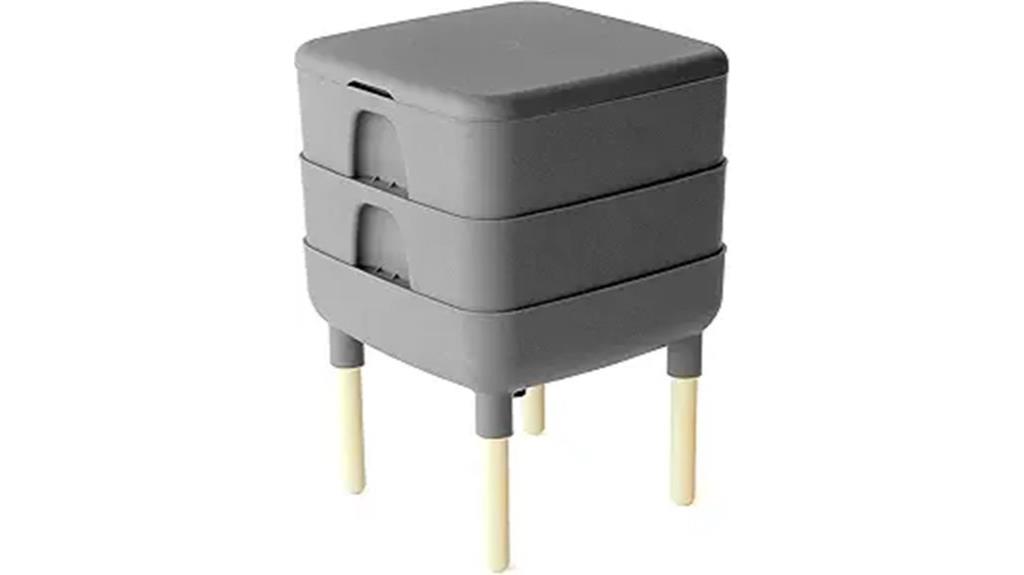
When selecting a compact, efficient worm composting bin suitable for indoor or outdoor use, the FCMP Outdoor Living Composter (HF-LC4000v2-GRY) stands out. Made from BPA-free, UV-inhibited recycled polypropylene, it’s durable and safe for contact. Its 8-gallon capacity fits small spaces, and the two trays facilitate easy worm migration and moisture control. The system includes a reservoir for worm tea, which can be diluted for fertilizing plants. Easy to assemble and maintain, it produces rich compost with minimal odor. Perfect for beginners or limited spaces, this composter offers a user-friendly way to turn kitchen waste into nutrient-rich soil year-round.
Best For: small-space gardeners, beginners, and indoor or outdoor composting enthusiasts seeking an easy-to-use, durable worm composter.
Pros:
- Made from BPA-free, UV-inhibited recycled polypropylene for durability and safety
- Easy to assemble and maintain with effective moisture and worm migration features
- Produces rich compost and worm tea with minimal odor, suitable for year-round use
Cons:
- Worms are not included and need to be purchased separately
- Some users report that the lid may not fit tightly, requiring modifications for pest prevention
- Limited capacity (8 gallons) may not be sufficient for larger composting needs
Worm Factory® 360 Black US Made Composting System
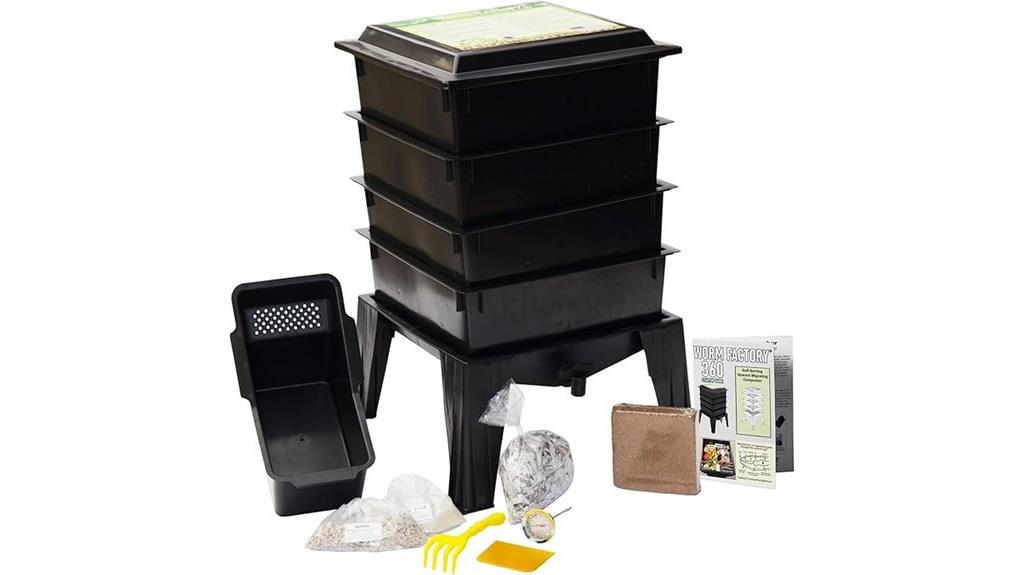
If you’re looking for an efficient indoor composting solution, the Worm Factory® 360 Black US Made Composting System stands out with its four customizable trays that cater to various household sizes. Its nested tray design promotes worm migration, making compost harvesting straightforward. Made from durable, sleek black plastic, it’s space-efficient and easy to assemble with clear instructions. The system supports odor control, includes a drainage spigot for excess liquids, and comes with bedding materials and tools for maintenance. With a capacity of 1 liter, it’s perfect for turning kitchen waste into rich compost while fitting neatly into your home environment.
Best For: Homeowners and apartment dwellers seeking an easy, odor-controlled indoor composting system to recycle food waste and produce nutrient-rich compost.
Pros:
- Easy to assemble and use with clear instructions.
- Space-efficient design suitable for indoor environments like kitchens or basements.
- Includes features like odor control, drainage spigot, and customizable trays for convenience.
Cons:
- Capacity of 1 liter may require frequent compost harvesting for larger households.
- Requires regular monitoring of moisture and worm activity for optimal results.
- Limited to indoor use; not designed for outdoor composting needs.
5-Layer Worm Compost Bin, 85L Worm Composter for Indoor & Outdoor
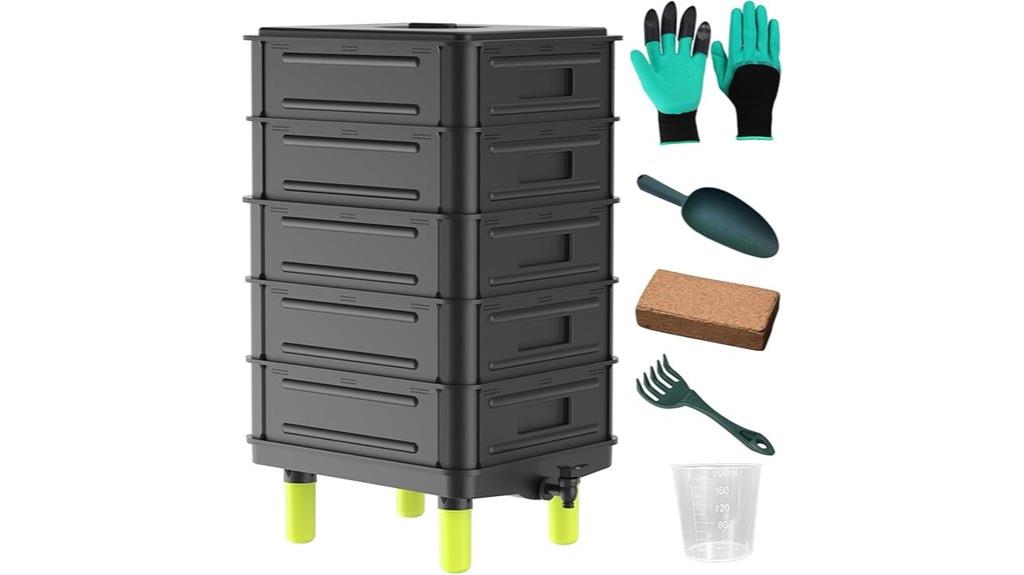
The Layer Worm Compost Bin with an 85L capacity is an excellent choice for gardeners and compost enthusiasts who want a versatile, space-saving solution for both indoor and outdoor use. Made from durable black PP plastic, it features five removable worm trays with handles, allowing easy waste addition and compost collection. The built-in faucet simplifies fertilizer draining, while the air ventilation system minimizes odors and promotes aeration. Its rectangular design measures 17.7L x 13.7W x 25.6H, weighing around 12.82 pounds. The system comes with accessories like gloves, a coconut brick, and tools, making it user-friendly and efficient for transforming kitchen scraps into rich compost.
Best For: home gardeners, organic waste enthusiasts, and space-conscious individuals seeking an efficient indoor or outdoor composting solution.
Pros:
- Large 85L capacity with five removable trays for easy waste management and compost collection.
- Built-in faucet for convenient fertilizer drainage and an air ventilation system to reduce odors.
- Made from durable, high-quality black PP plastic with accessories included for easy setup and use.
Cons:
- Trays are not one solid piece, which may lead to gaps or pests if not properly maintained.
- Instructions can be unclear or lacking, requiring online resources or videos for proper assembly.
- Some users have reported quality concerns, such as cracking or cheap materials upon arrival.
5-Tray Worm Composter, 100L Worm Compost Bin for Vermicomposting
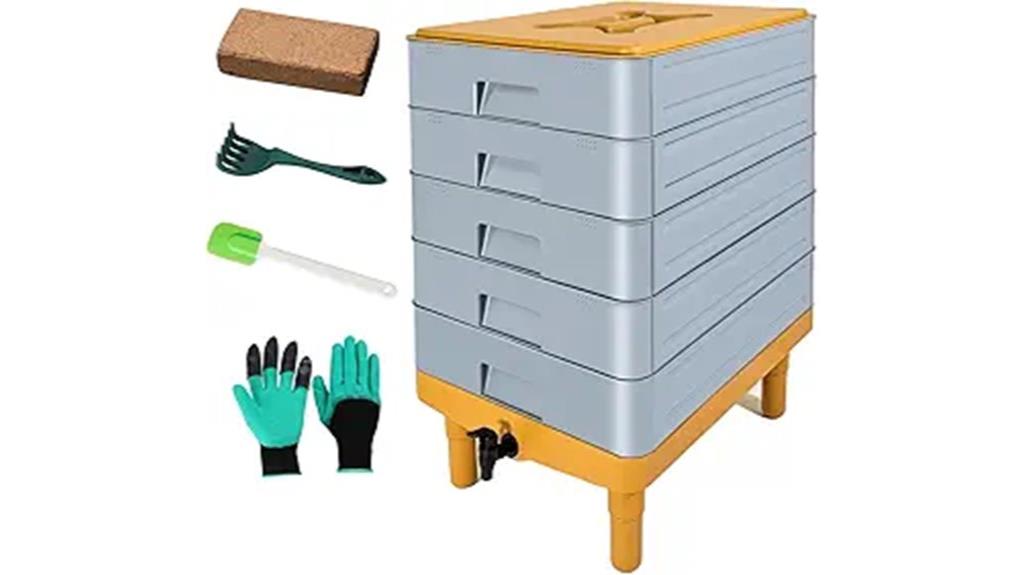
The 5-Tray Worm Composter, with a generous 100L capacity, is ideal for those seeking efficient vermicomposting at home or in small spaces. Its five reusable trays make adding waste, maintaining worms, and harvesting compost straightforward. Made from durable black PP plastic, it’s suitable for both indoor and outdoor use. The included faucet simplifies fertilizer extraction, making nutrient-rich compost easy to collect. Designed with proper ventilation to promote oxygen flow and odor control, it operates odorlessly. The simple stacking system ensures quick setup and easy maintenance, while the included accessories—gloves, shovel, coconut bricks, and scraper—enhance the composting experience for beginners and pros alike.
Best For: home gardeners, small-space urban dwellers, and beginners seeking an efficient and odorless way to compost organic waste indoors or outdoors.
Pros:
- Large 100L capacity with five reusable trays for easy waste management and harvesting
- Made of durable, weather-resistant black PP plastic suitable for indoor and outdoor use
- Includes faucet and accessories for convenient fertilizer extraction and user-friendly composting
Cons:
- May be too large for very limited indoor spaces or small-scale composting needs
- Requires initial setup and occasional maintenance to ensure proper ventilation and operation
- Comes with additional accessories that might not be necessary for experienced composters who already own tools
VIVOSUN 5-Layer Worm Compost Bin, 50L Worm Composter
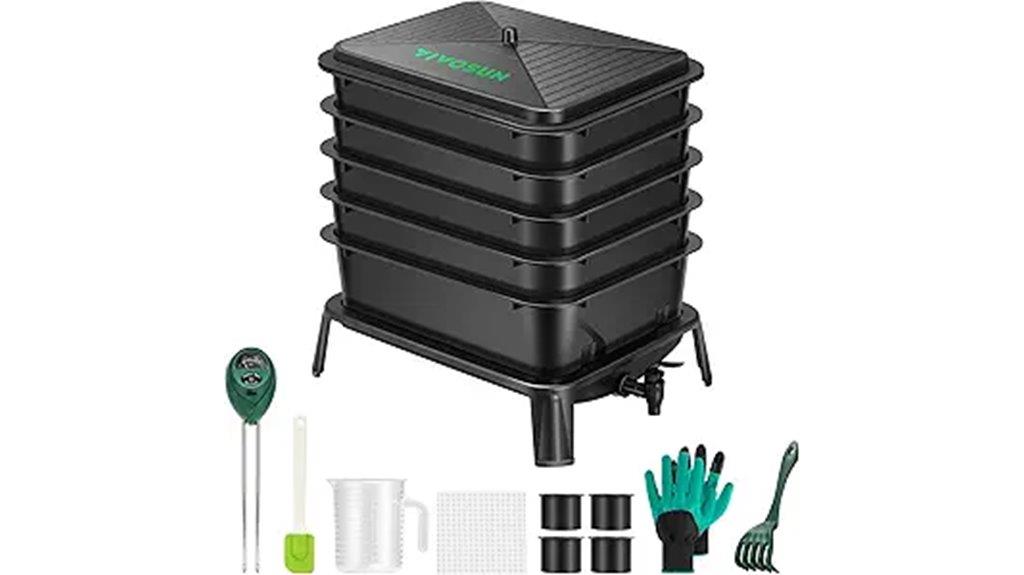
Ideal for small to medium households, the VIVOSUN 5-Layer Worm Compost Bin offers a compact yet spacious solution for efficient vermicomposting. With a 50L capacity, it handles plenty of kitchen scraps while fitting comfortably in kitchens, balconies, or gardens. Its multilayer design makes waste separation easy and keeps the process organized. The bin’s ventilation slits ensure good airflow, reduce odors, and support active worms. Setup is quick, taking only minutes, and the included accessories, like a spigot for worm tea and handling tools, make composting simple. Overall, it’s a reliable, space-efficient option for turning kitchen waste into nutrient-rich soil.
Best For: small to medium households seeking an efficient, space-saving solution for vermicomposting and converting kitchen waste into nutrient-rich compost.
Pros:
- Compact design with a 50L capacity suitable for limited spaces
- Easy setup with detailed instructions and included accessories
- Excellent ventilation slits reduce odors and promote healthy worm activity
Cons:
- Smaller capacity than some users expect for larger-scale composting
- Limited instructions beyond initial setup, leading to potential confusion
- Occasional issues with fruit flies despite following guidelines
2-Pack Inground Worm Composter for Gardens and Home
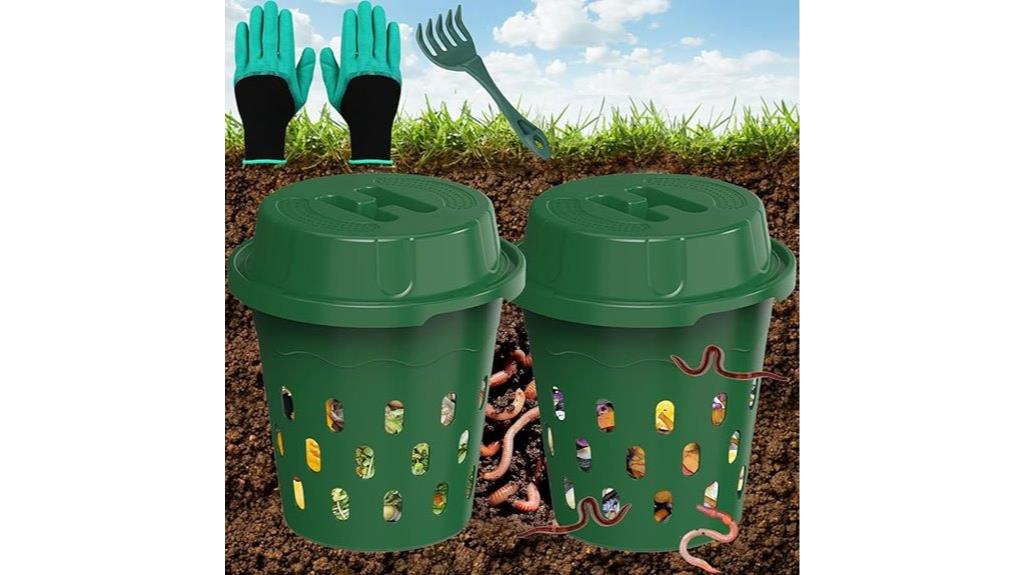
If you’re looking for an easy way to turn kitchen scraps into nutrient-rich compost, the Pack Inground Worm Composter for Gardens and Home is an excellent choice. These compact, durable PVC bins measure 9.5×9.5×10.8 inches and hold about 8 liters each, perfect for small gardens or yard beds. You simply dig a hole, bury the bins, and start composting organic waste like kitchen scraps, leaves, or paper. The dual-bin system allows continuous composting, with worms converting waste into rich compost in just 2-3 months. It’s simple to manage, discreet, and odor-free—ideal for beginners and eco-conscious families alike.
Best For: eco-conscious families and beginners seeking an easy, efficient way to compost kitchen waste outdoors in small gardens or yard beds.
Pros:
- Simple to bury and maintain with no complex assembly required
- Durable PVC construction built for outdoor use and weather resistance
- Supports continuous composting with a dual-bin system for year-round waste recycling
Cons:
- Takes several months to produce usable compost
- Small size may limit the amount of waste processed at once
- Requires digging holes for installation, which may be challenging for some users
5-Tray Worm Compost Bin, Dark Green with Free Worm-Saver Tray
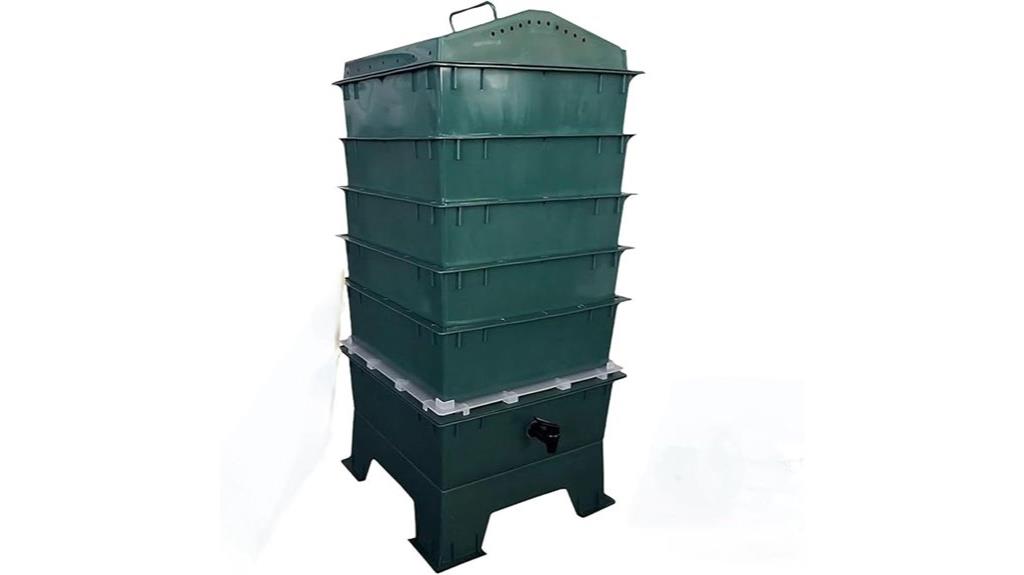
A tray worm compost bin with a free worm-saver tray, like the VermiHut 5-Tray system, is perfect for those seeking an efficient, compact solution for indoor or small outdoor spaces. Made from durable HDPE, it offers a 50-liter capacity with stackable trays that maximize space while ensuring airflow and moisture control. Its dome-shaped lid with air vents maintains ideal bedding conditions and odorless operation. The included worm-saver tray prevents worms from dropping into liquid trays, making harvesting easier. Easy to assemble and maintain, this system transforms kitchen waste into rich compost, supporting eco-friendly living in limited spaces.
Best For: indoor gardeners, small-space composters, and eco-conscious households seeking efficient and odorless kitchen waste recycling solutions.
Pros:
- Compact, stackable design maximizes space and ensures excellent airflow and moisture control.
- Easy to assemble, maintain, and harvest, making composting simple and low-maintenance.
- Includes a worm-saver tray to prevent worms from dropping into liquid trays, facilitating cleaner harvesting.
Cons:
- Limited capacity may require multiple systems for larger waste volumes.
- Requires regular monitoring of moisture and worm activity for optimal performance.
- May need additional accessories, like moisture meters or bedding materials, for best results.
Urban Worm Bag Worm Composting Bin Version 2
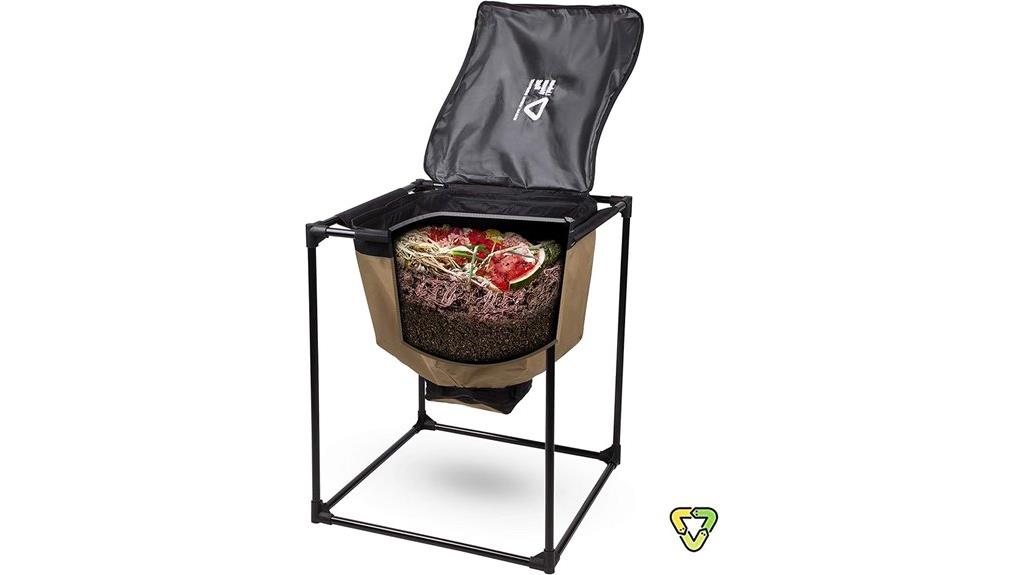
The Urban Worm Bag Worm Composting Bin Version 2 stands out for its innovative, patent-pending design that eliminates the need for bottom zippers while offering a large composting capacity. Made from durable 900D water-resistant oxford fabric, it features a square shape measuring about 26.75 inches wide and 31.75 inches tall, with over 5 cubic feet of volume. It can hold up to 8 pounds of worms, processing 3-4 pounds of waste daily. The lightweight iron frame ensures stability, and breathable fabric keeps conditions aerobic, preventing odors. Assembly takes less than five minutes, with no tools needed, making vermicomposting simple and efficient.
Best For: urban dwellers and small-space gardeners seeking an easy, efficient way to compost household waste with minimal setup and maintenance.
Pros:
- Quick, tool-free assembly in less than five minutes.
- Large capacity of over 5 cubic feet, suitable for significant waste processing.
- Breathable fabric promotes aerobic composting, reducing odors and overheating.
Cons:
- May require regular moisture checks and spritzing to maintain proper bedding humidity.
- Initial setup from scratch can take 4-6 months before harvesting worm castings; using existing compost accelerates this.
- Some users might find the need to open the bottom for dry bedding during harvests slightly inconvenient.
Arcadia Worm Composting Bin Kit (WN55, 4-Tray)
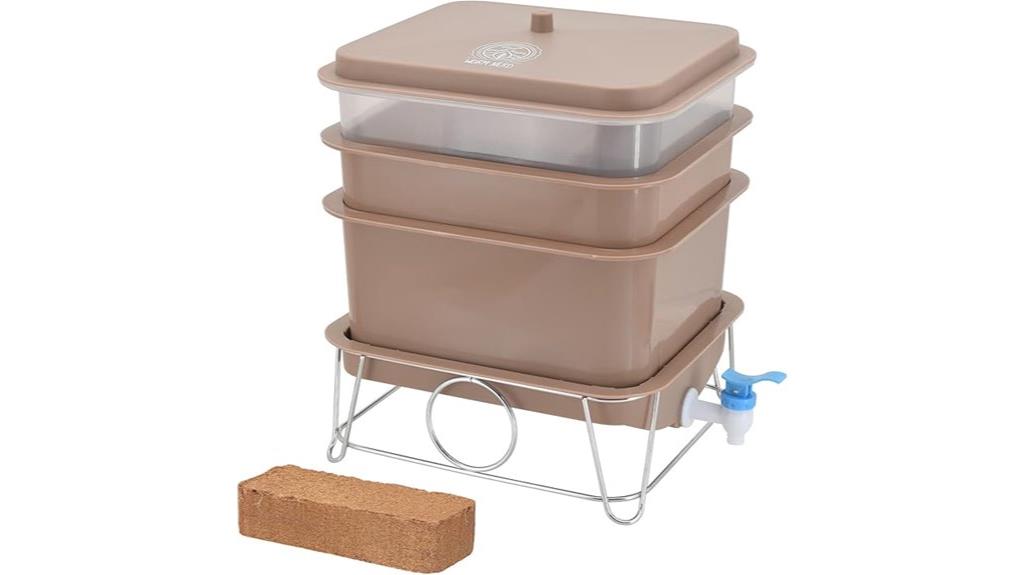
Designed for small spaces and indoor use, the Arcadia Worm Composting Bin Kit (WN55, 4-Tray) offers a compact and efficient solution for vermiculture enthusiasts. Its four-tray design includes three screened trays for worms and compost, plus a base tray to collect liquid fertilizer, making it easy to harvest worm tea. Made from durable plastic, it measures approximately 10×9 inches and weighs just 2.4 pounds, making it lightweight and portable. Features like built-in aeration, drainage holes, and a spigot with a rubber seal help maintain ideal conditions. While some users note size limitations and quality control issues, overall, it’s a practical choice for indoor composting.
Best For: small-space dwellers and indoor gardeners seeking an easy, compact vermicomposting solution.
Pros:
- Compact and lightweight, ideal for small spaces like countertops and greenhouses
- Features built-in aeration and drainage for maintaining optimal worm environment
- Easy to assemble and operate, with a convenient liquid fertilizer spigot
Cons:
- Small size limits the amount of compost and worm activity, suitable mostly for small households
- Some users report quality control issues with the spigot and potential for worms to escape
- Outdoor use may require additional protection from rain and pests
Vego Garden In-Ground Worm Composter Twin Pack
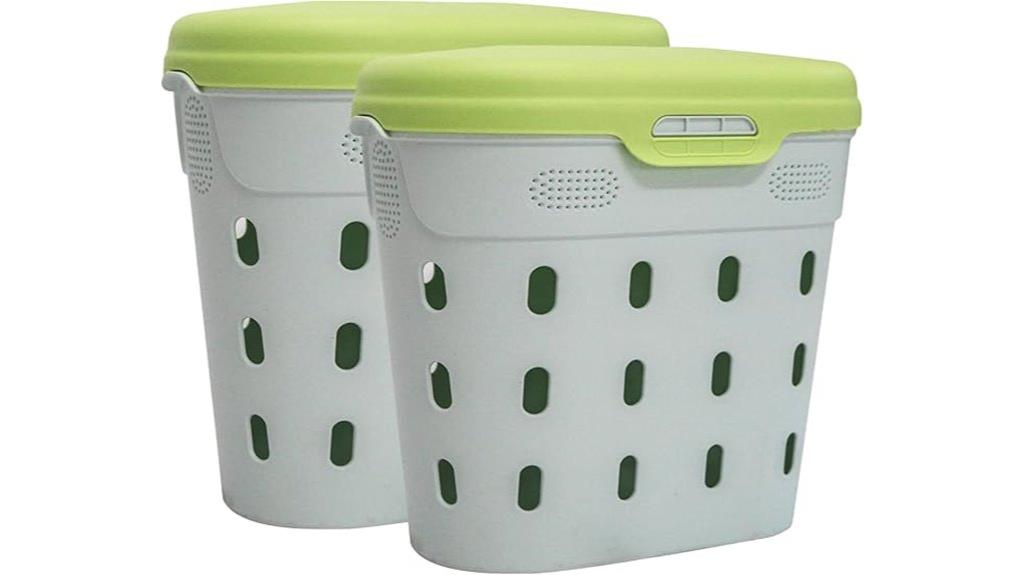
If you’re looking for an efficient, eco-friendly way to compost organic waste directly in your garden, the Vego Garden In-Ground Worm Composter Twin Pack offers an excellent solution. Made from durable, BPA-free polypropylene, these 8-gallon bins are designed for outdoor use and can be buried in ground or placed in raised beds. They speed up composting, turning kitchen scraps and garden waste into nutrient-rich compost in just 2-3 months. The twin pack provides a cost-effective, sustainable way to support healthy soil, reduce landfill waste, and promote cyclical gardening. Easy to set up, these composters feature ventilation for odor control and are built for lasting outdoor performance.
Best For: gardeners seeking an eco-friendly, efficient in-ground composting solution for organic waste reduction and soil enrichment.
Pros:
- Accelerates composting process, producing nutrient-rich soil in 2-3 months
- Durable, BPA-free construction suitable for outdoor use and long-term durability
- Easy to install in ground or raised beds, promoting sustainable gardening practices
Cons:
- The 8-gallon size may be too large for small or limited garden spaces
- Some newer models have lid designs that are difficult to snap on or off, requiring additional weights for security
- Burying the bin properly requires effort and may not be convenient in all garden layouts
Underground Worm Farm for Outdoor Gardening
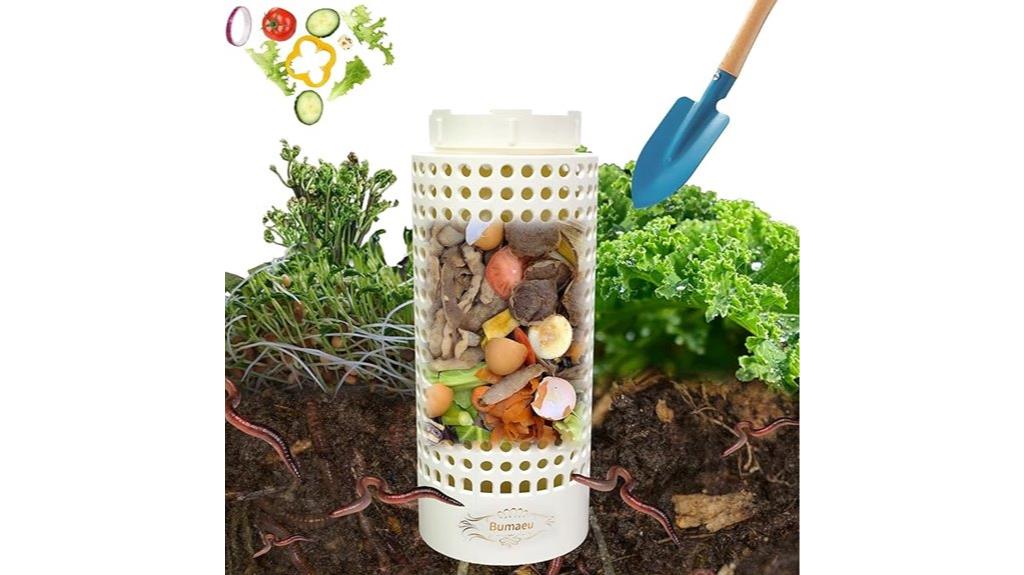
An underground worm farm like the Garden Mini Vermicomposting Bin is perfect for gardeners with limited space who want to convert kitchen waste into nutrient-rich compost outdoors. Its compact design measures just 10.2×4.3×4.3 inches, fitting into only 4.33 square inches of ground, yet it effectively improves soil within a 3-foot radius. Made of PVC, it’s lightweight and easy to bury—simply dig a hole, insert, add organic waste, and let nature do its work. Features like a safety lock cover, breathable valve, and multiple inlets ensure proper airflow and odor control. It’s a simple, eco-friendly way to support outdoor composting in small gardens.
Best For: gardeners with limited space seeking an efficient and eco-friendly outdoor composting solution for small-scale organic waste conversion.
Pros:
- Compact and space-saving design suitable for small gardens or limited outdoor areas
- Easy to install with simple bury-and-use setup, requiring minimal maintenance
- Odor-free operation with effective gas discharge and airflow management
Cons:
- Small capacity may limit the volume of compost produced over time
- Worms may not acclimate well, affecting composting efficiency for some users
- May not be suitable for larger-scale composting needs or bigger garden spaces
Worm Bucket Indoor Composting Kit for Making Worm Castings and Worm Tea

The Worm Bucket Indoor Composting Kit is an excellent choice for those living in small spaces who want to start composting indoors. It has a 2.5-gallon capacity, made from food-safe plastic, and features a compact, square design perfect for apartments, condos, RVs, or tiny homes. The kit includes a worm bin, coco coir brick, perlite, and detailed instructions, making setup straightforward. It also has a spigot for collecting worm tea, which helps fertilize plants. Easy to use and beginner-friendly, this kit simplifies turning kitchen scraps into rich worm castings and tea, all while fitting neatly into limited spaces.
Best For: apartment dwellers, small-space gardeners, and beginners interested in indoor composting and worm tea production.
Pros:
- Compact and lightweight design ideal for limited spaces like apartments and RVs
- Includes comprehensive starter materials and clear instruction guides for easy setup
- Produces nutrient-rich worm castings and tea, enhancing indoor plant growth
Cons:
- Small capacity may require more frequent feeding and maintenance
- Vents and handles can be awkward or challenging to adjust, risking leaks or injury
- Shipping packaging can create a mess with dispersing perlite dust and loose materials
Factors to Consider When Choosing Worm Composting Bins
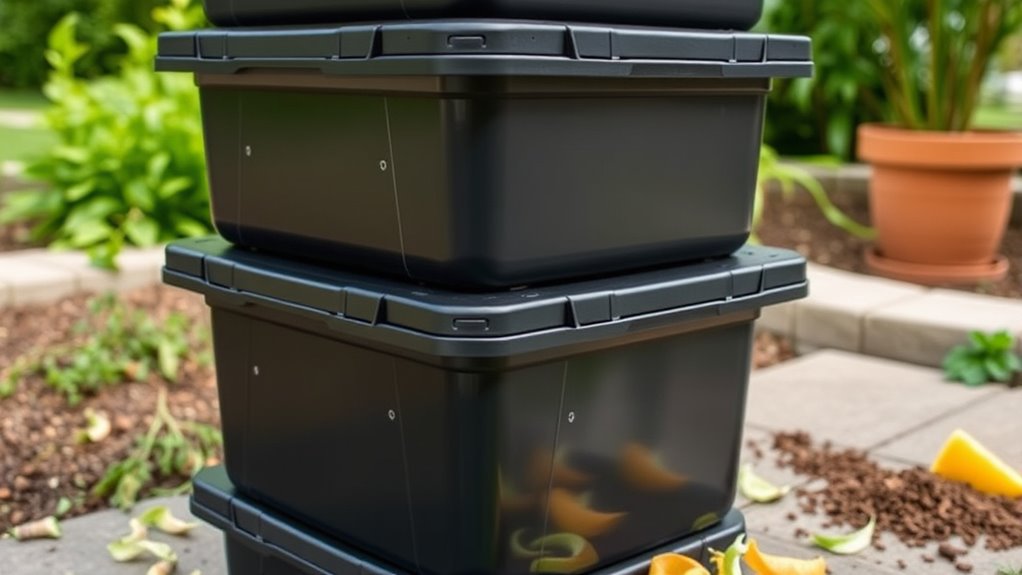
When selecting a worm composting bin, I consider factors like size and capacity to fit my space and needs. I also look at the material’s durability and how well the bin promotes ventilation to prevent odors. Finally, ease of assembly and odor control features are essential for a hassle-free, clean composting experience.
Size and Capacity
Choosing the right size and capacity for a worm composting bin is essential to guarantee it meets your waste management needs without causing issues. The size determines how much organic waste the bin can process and how many worms it can support. Larger bins, over 85 liters, handle more waste and produce more compost and worm tea, making them ideal for bigger households or frequent composters. Smaller bins, under 50 liters, are perfect for limited spaces or light daily waste, which suits beginners or indoor setups. It’s important to match the bin’s capacity with your household’s waste generation to avoid overfilling or under-utilization. Additionally, ensure the bin can support an appropriate worm population; overcrowding can harm worm health and slow composting.
Material Durability
Material durability plays a vital role in selecting a worm composting bin because it determines how well the bin withstands weather, pests, and daily wear. High-quality plastics like BPA-free HDPE or polypropylene are popular choices because they’re UV-resistant and won’t crack, warp, or degrade from sunlight exposure. Resilient materials keep the bin structurally sound when filled with moist bedding and organic waste, minimizing leaks or breakage. While metal components or reinforced plastics can offer extra strength, they might rust or corrode if not properly coated or maintained. Choosing a material with proven resistance to moisture and temperature changes ensures your worms stay in excellent conditions and reduces replacement costs. Ultimately, a durable bin offers longevity, saving you time and money in the long run.
Ventilation Effectiveness
Effective ventilation is crucial for maintaining a healthy worm composting environment, as it guarantees a steady flow of oxygen needed for worm respiration and efficient decomposition. Good airflow helps prevent excess moisture buildup, which can cause odors and promote anaerobic conditions harmful to worms. Features like built-in vents, adjustable airflow holes, or mesh panels are essential for proper aeration. Without sufficient ventilation, the bin can become compacted, overheated, or prone to worm escapes and disease. Regularly checking and adjusting ventilation features ensures the environment remains balanced, promoting faster breakdown of organic matter. When choosing a bin, prioritize those with effective airflow options to maintain ideal oxygen levels and create a healthy, odor-free habitat for your worms.
Ease of Assembly
When selecting a worm composting bin, ease of assembly can make a significant difference in how smoothly your setup process goes. Features like snap-together trays, minimal tools required, and clear, step-by-step instructions simplify the process and reduce frustration. Modular designs with removable components allow for quick setup and easier maintenance, saving you time and effort. Pre-drilled holes and built-in ventilation options streamline assembly without extra hardware, making the process even easier. Lightweight materials and compact sizes also help, especially if you need to move or position the bin in tight spaces. Additionally, user-friendly systems often include visual guides or color-coded parts, which assist in proper tray stacking and placement, ensuring you get your worm composting system up and running with minimal fuss.
Odor Control Features
Choosing a worm composting bin with good odor control is essential to keep your space clean and odor-free. Features like ventilation holes, odor-vented lids, and built-in odor absorbers such as coconut fiber or activated carbon help minimize smells. Proper moisture regulation is also key; design elements like water retention channels or moisture-absorbing bedding prevent excess humidity that causes odors. Multi-tray systems with separate compartments promote better airflow and reduce anaerobic conditions that produce foul smells. Additionally, liquid collection bases or spigots allow for easy removal of excess leachate, preventing stagnation and odor buildup. Regular maintenance, like avoiding overfeeding and covering waste properly, complements these features and ensures your worm bin stays fresh and odor-free.
Cost and Value
Considering the cost and value of worm composting bins helps guarantee you get the best return for your investment. Prices vary widely, from budget options around $20 to premium systems over $150. Higher-priced bins usually offer larger capacity, better durability, and more features, making them a smarter long-term choice for active composters. Cheaper bins may have limited features, smaller sizes, or lower-quality materials, which can reduce effectiveness and lifespan. Adding accessories like liquid collection trays, tools, or detailed guides can boost a bin’s worth. To choose wisely, weigh the cost against factors like durability, capacity, efficiency, and included features. Doing so ensures you select a worm bin that meets your needs without overspending, delivering good value over time.
Frequently Asked Questions
How Often Should I Harvest Worm Castings From My Bin?
When it comes to harvesting worm castings, I usually do it every 3 to 6 months, depending on how much kitchen waste I add. I look for the castings to be dark, crumbly, and earthy-smelling. If I notice an accumulation at the top or a strong odor, I harvest sooner. Regular harvesting maintains my bin healthy and ensures my worms stay happy and productive.
Can Worm Composting Bins Handle Large Quantities of Kitchen Waste?
Worm composting bins can handle quite a bit of kitchen waste, but it depends on the bin size and worm population. I find that adding waste gradually helps prevent overloading. If you’re dealing with large quantities regularly, consider upgrading to a bigger bin or setting up multiple bins. Monitoring moisture and aeration is essential too—this keeps your worms healthy and your composting efficient.
What Are the Signs of Overfeeding Worms?
When overfeeding worms, I notice excess food not breaking down, which causes foul odors and a soggy bin. Worms may also cluster near the surface, avoiding the uneaten scraps. If I see mold or fruit flies, I know I’ve given too much. To keep my compost healthy, I feed them small amounts, stir often, and remove any leftovers before they start to smell.
How Do I Prevent Odors in My Worm Composting System?
Imagine a fresh breeze wafting through my compost, not a foul smell. To prevent odors, I make sure my worm bin stays balanced: I add enough bedding to absorb moisture, avoid overfeeding, and keep food buried under bedding. I also drain excess liquid regularly and avoid meat or dairy, which cause smells. Proper airflow and moisture levels keep my worm bin smelling fresh, turning waste into rich soil without any unpleasant odors.
Are Worm Composters Suitable for All Climate Conditions?
Worm composters can be suitable for many climate conditions, but I’ve learned they need some adjustments in extreme weather. In hot climates, I keep my bin in a shaded area and add plenty of bedding to prevent overheating. In cold weather, I insulate my bin or bring it inside. Overall, with a little care, I’ve found worm composting works well almost anywhere, just requires some climate-specific tweaks.
Conclusion
Remember, whether you’re just starting out or a seasoned composter, the right bin makes all the difference. With so many great options on the list, you’re sure to find one that fits your space and needs. Don’t forget, “The best time to plant a tree was 20 years ago; the second best time is now.” So, start composting today and watch your garden flourish!

